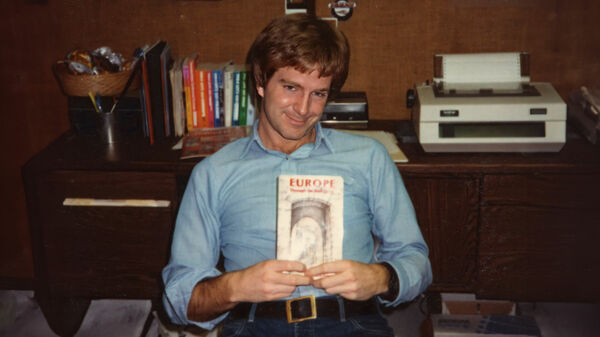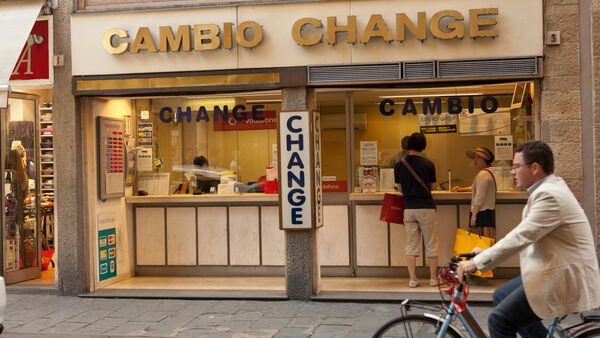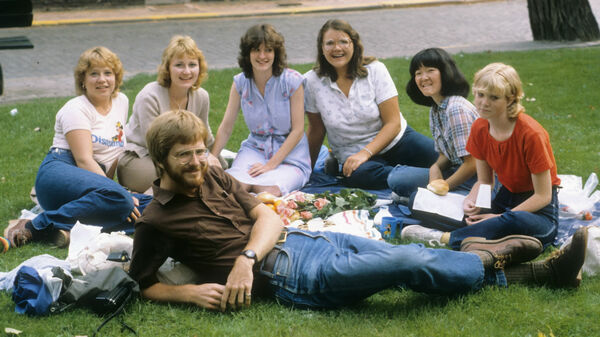Europe Through the Back Door at 40



I self-published the first edition of my travel skills handbook, Europe Through the Back Door, in 1980. Recently, the arrival of our 40th edition put me in a nostalgic mood. As I flip through that original book, it's clear to me that many of the specifics about traveling in Europe have changed dramatically. But at the same time, I'm struck by how good travel remains fundamentally the same.
In that first edition — back when I was a budding travel writer in my early 20s — I was preoccupied with certain topics that look nothing like my travels today. Lengthy passages offer tips on hitchhiking, and on sleeping for free: in parks, on trains (or at train stations), and crashing on a distant friend-of-a-friend's couch. I noted, "If I had the money, I would spend most of my European nights in hotels. On a limited budget, I avoid hotels like the plague." The backpacker on a serious budget rarely paid for a hotel bed or a restaurant meal…and arguably had a more fun and memorable experience than those who spent five times as much per day, and only slept in hotels and ate in restaurants.
And when I did stay at hotels, they were hardly splurges. Here's one tip that, thankfully, feels very outdated now: "Some hotels run out of hot water in the middle of the day. To assure yourself of a hot shower, take it in the morning." (Based on this hard-earned wisdom, in our early phrase book, we included the line "At what time is the water hot?")
I included detailed instructions on getting and using traveler's checks, which I deemed "The best way to carry money in Europe." I also advised: "Bring American dollars (Europeans get a kick out of seeing George Washington become a mushroom) for situations when you only want to change a dollar, not a whole traveler's check." (To mushroom George, fold a dollar bill so his neck connects directly to his forehead.)
The ever-increasing expense of traveling in Europe was as relevant then as it is in our age of inflation. Here were my thoughts back in 1980:
In the six years I've been teaching travel, my notes on budgeting for a European vacation have had to be continually revised. Obviously, it is getting harder and harder to do "Europe on the Cheap." We've seen the end of Europe on $5 a Day. Europe on $10 a Day lasted a few years. I expect Mr. Frommer will have to give up $15 a day in a year or two, and the 1980s may see Europe on $20 a Rest Stop. In travel, two things seem to be certain: The dollar will drop and prices will rise.
In 1980, I led a small group around Europe on a three-week tour. By following some basic guidelines, we thrived on $14 per day per person budget (enjoying good sleep, good food, and never compromising our health or safety). It can be done!
And I had some thoughts on driving in Europe:
Europe is a continent of frustrated race car drivers. The European gets a feeling of power as his wheels squeal and chickens learn to fly. The American who finds himself behind the wheel of a rental car may be bullied to a near standstill. Contrary to American road etiquette, there is little room for politeness on the thoroughfares of Europe. Coping is not impossible; in fact, I've found it easy — and even fun. You must be aggressive, wear your seat belt, and be certain to pay the extra money for a complete insurance policy with a non-deductible clause.
When it came to transportation — in that age before budget flights — I advised: "Europe is a small continent, and most plane fares are quite expensive. There are a few budget flights available, but unless you have a lot more money than time, you are generally better off on the ground." Cheekily, I also listed "The 15 Safest Airlines" and "The 15 Most Dangerous Airlines" — ranked by the statistical likelihood of a plane crash.
Flipping through the book, I recall a time when southern countries were Europe's bargain basement: "Many people might disagree with me, but I would say that, with discretion and common sense, you can eat and drink whatever you like anywhere in Europe. If any area deserves a little extra caution, it is the southern countries of Spain, Portugal, Italy, and Greece." Today, those four places are among the most popular culinary destinations in all of Europe.
In those backpacking days — when Europe was much less crowded than it is today, and you could often just breeze into town and find an adequate hotel room — I preached flexibility:
Are reservations a good idea? Generally, no. I have some reservations about booking ahead. If you require a specific hotel or a special location, or you anticipate crowd problems (like during a festival), then a reservation may be wise.
I have had reservations, but I don't like them for three reasons: First, you can't see what you're getting before you buy it. I like to personally inspect the room before accepting. Second, reservations destroy your flexibility. I never travel exactly as originally planned, and being stuck in a rigid calendar of hotel reservations all summer would be a real blow to the independence and spontaneity that I like to exercise when I travel. You can never really predict just how long or how short you will want to stay in a place until you get there. Third, reservations are more expensive. From the USA, I tried, but could not reserve a room anywhere in London for less than $60. I'm sure it would have been a fine room, but I didn't have $60 for a fine room. I went to London and found a simple but wonderfully adequate double for $30. These cheaper hotels are not listed in the travel agent's reservation book. You must go there and find them.
I also offered this pearl of wisdom for room-seekers: "A person staying only one night is bad news to a hotel. If, before telling you whether there's a vacancy, they ask you how long you will stay, be ambiguous."
On the topic of flexibility, another big issue was "mail stops." Hard as it is for today's travelers to imagine, homesick globetrotters used to instruct their friends and family back home to send them mail, "general delivery," at designated post offices around Europe. (Given the high cost of transatlantic phone calls, this was the most cost-effective way to get word from home.) Here was my advice:
Minimize "mail stops." Arrange mail pickups before you leave. Some American Express offices offer a free clients' mail service for those who have an AmExCo card or traveler's checks. Friends or relatives (unless they live in Eastern Europe) are fine for mail stops. Every city has a general delivery service. Pick a small town where there is only one post office and no huge crowd problems to deal with. Have letters sent to you in care of "General Delivery" (or Post Restante in French-speaking cities). Tell your friends to print your surname in capitals and omit your middle name. If possible, do not use the Italian mail.
Mail pickup commitments cut drastically into your flexibility. Stale mail is not worth designing your trip around. Every year my mail stops are farther apart. Once a month seems about right for me. If you get homesick, mail just teases you, stirring those emotions and aggravating the problem. The best remedy for homesickness is to think of Europe as your home. Until you return to the United States, your home is right where you are. Be at home in Europe.
Re-reading this, it's hard to imagine the low-tech inefficiency of snail-mailing updates back and forth across the Pond. But more than that, I'm struck by how that final bit of advice is as true as it ever was. Whether you're scheduling mail stops in the 1980s, or addicted to TikTok or Instagram in the 2020s, it's so tempting to remain tethered to your home life while on the road. But it's much more satisfying to do the 21st-century equivalent of "minimize mail stops" — tuck your phone in your pocket — and truly be present in Europe.
Another timeless tip: how to find a great meal in Europe. Here's what I said in 1980 — and I'd say basically the same thing today:
Do not seek out the loud "We Speak English" signs or English menus. If you are concerned about handling the menu, carry a small menu translator. If you are really at a loss as to what to order, look around and, if you see something that looks good on someone else's table, point to that and order it. You can't go wrong. People are generally understanding and helpful to the poor monoglot tourist. If they are not, then you probably picked a place that sees too many tourists. It seems to me that Europeans with the most patience with the tourists are the ones who rarely deal with them.
To maximize my cultural experience, I never order the same meal as my travel companion — we order different dishes and share them. This way, we sample twice as many dishes and try something risky, like snails or squid, without risking the whole meal.
While I am the first to admit that restaurant meals are an important aspect of any culture, I picnic for the majority of my meals. This is not solely for budgetary reasons. I love to dive into a marketplace and actually get a chance to do business.
Another fundamental truth is the need to equip yourself with good information. This is still my standard operating procedure:
Without information you'll be lost in a large city. Prepare for a city as you approach by train. Spend the last hour before you arrive reading and planning. Know what you want to see. Prepare an efficient strategy or plan of attack, covering the city systematically (area by area), keeping free days and closed days in mind. It's easy to spend an hour on subways and buses to get to a sight and realize the next day that just across the street there was something else you wanted to see. It is just as easy to get to that place and find that today it is closed. Most sites are closed for one weekday, and many are free on one weekday. Consider the crowds that visit on free days, and you might prefer to pay for a quieter museum.
Rereading that first edition of Europe Through the Back Door, I really appreciate the sense of humor. Remember, travel is supposed to be fun! Here are a few nuggets that made me laugh out loud:
You will often find a "long-life" kind of milk that needs no refrigeration. This milk will never do two things — go bad or taste good.
And this:
Europe is getting so expensive for the American that it's a good idea to save your souvenir shopping for the cheaper countries. I remember buying a cuckoo clock for $3 ten years ago, and now, a hamburger, shake, and fries at the Munich McDonald's will cost more than that. For the price of an eight-inch pewter Viking ship in Norway, you can buy an actual boat in Portugal.
That first edition featured some key survival phrases in German, French, Italian, and Spanish. Along with the expected pleasantries, I included some oddball insults: "hairy creep," "bloodsucking leech," and "repulsive, evil-smelling dog." Also included were translations for "Your lips are like wet liver," "Do any of your customers ever come back?", "May I have another plate for the maggots?", and "This isn't second class. it's degradation." (We do a more thoughtful job these days of helping travelers hurdle the language barrier in our phrase books. But we've kept our sense of humor…and a few good-natured insults, too.)
I'll finish this nostalgic trip through the first edition of Europe Through the Back Door with my recommended "Pack Light" list for summer travel. If you ever wondered how 25-year-old Rick managed to travel for months at time with one small rucksack, here was my inventory:
☐ One pair long pants
☐ Walking shorts with plenty of pockets – doubles as a swimsuit
☐ Two T-shirts
☐ Long-sleeved shirt
☐ Dark, warm sweater – for warmth and for dressing up; it never looks wrinkled or dirty
☐ Light windbreaker jacket – folds up into pocket
☐ Underwear and socks – two sets
☐ One pair of shoes – sturdy sole, light, cool, comfortable, good-looking top
☐ Women's extras – summer dress, swimsuit
Our packing tips — and all our other advice — is more sophisticated now than it was then. (But fundamentally, that packing list has changed very little.) And it's clear to me that, even 40 editions later, if you equip yourself with good information and expect yourself to travel smart…you will. And the rewards of good travel are as rich as ever.

